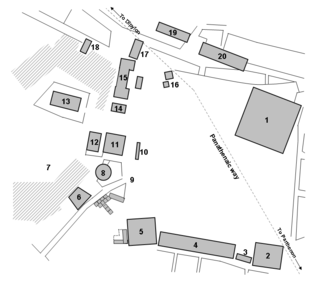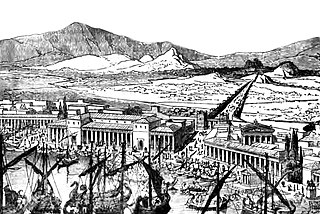 W
WThe Stoa of the Athenians is an ancient portico in the Delphic Sanctuary, Greece, located south of the Temple of Apollo. The southern side of the polygonal wall of the platform forms the north wall of the stoa. It was constructed c. 478 BC-470 BC during the early Classical period. The one-aisled stoa with Ionic colonnade opens toward the southeast. It was dedicated by the Athenians after the Persian Wars.
 W
WThe Stoa of Attalos was a stoa in the Agora of Athens, Greece. It was built by and named after King Attalos II of Pergamon, who ruled between 159 BC and 138 BC. The current building was reconstructed in 1952–1956 by the American School of Classical Studies at Athens and currently houses the Museum of the Ancient Agora.
 W
WStoa Basileios, meaning Royal Stoa, was a stoa constructed in Ancient Athens in the 6th century BC and substantially altered in the 5th century BC. It was located in the northwest corner of the Athenian Agora.
 W
WThe Echo Stoa is located within the sanctuary of Zeus in Olympia, Greece. It is part of an ancient archaeological site excavated and preserved by the German Archaeological Institute at Athens. A stoa is a covered walkway or portico, typically colonnaded and open to the public. In ancient Greece a stoa could be used for a variety of reasons including the selling and display of goods, and religious or public meetings. Aside from Delphi, this sanctuary was the most important one in Greece.
 W
WThe Stoa of Eumenes was a Hellenistic colonnade built on the South slope of the Acropolis, Athens and which lay between the Theater of Dionysus and the Odeon of Herodes Atticus The gallery was donated to the city of Athens by the king of Pergamon, Eumenes II, around 160 BC. Vitruvius makes reference to the building when speaking about the purpose of stoai erected near theatres that served as a refuge for the spectators in inclement weather conditions or as stores for theatre props.
 W
WThe Makra Stoa is an archaeological site which formed part of the urban fabric of the ancient city of Piraeus in Athens, Greece
 W
WThe Stoa Poikile or Painted Porch, originally called the Porch of Peisianax, was erected during the 5th century BC and was located on the north side of the Ancient Agora of Athens. The Stoa Poikile was one of the most famous sites in ancient Athens, owing its fame to the paintings and loot from wars displayed in it. The Stoa was the location from which Zeno of Citium taught Stoicism. The philosophical school of Stoicism takes its name from having first been expounded here, and was derived from the Greek word stoa. Zeno taught and lectured to his followers from this porch. Excavations carried out by the American School of Classical Studies at Athens over the past two decades have revealed much of the foundations and some lower elements of the stoa on the north side of the Athenian Agora; it had a Doric columnar facade and an Ionic interior colonnade.